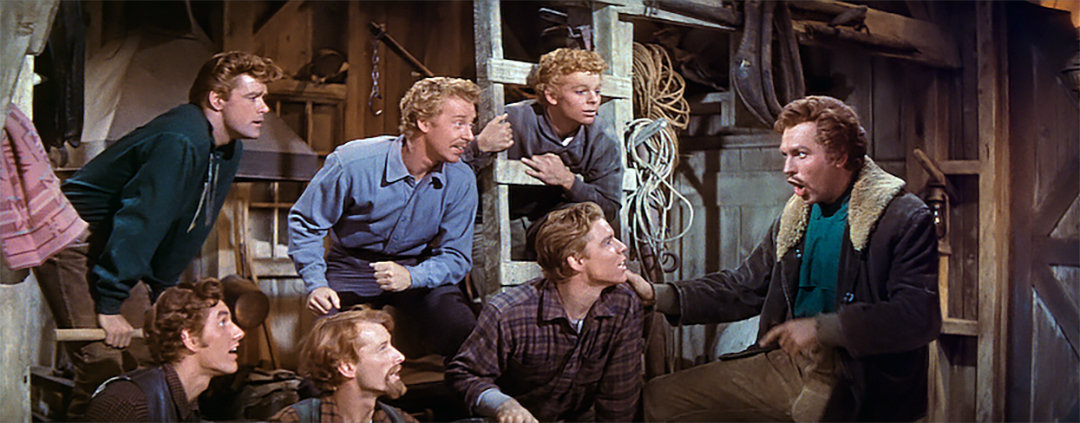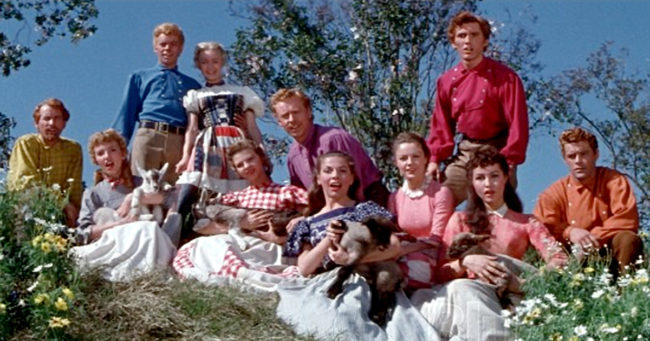Sobbin’ Through the Centuries
In the mid-8th century BCE, they were kidnapped and raped. In the mid-20th century CE, they were kidnapped and fell in love.
After centuries of being retold, Livy’s account of the Sabine Women is romanticized through melodramatic storytelling and the magic of 1950s musicals.
Sobbin’ Sabines
In 1938, Stephen Vincent Benet parodied the tale of the Sabine Women in his short story The Sobbin’ Women. And in 1954, Stanley Donen adapted this tale for the screen, transforming it into the musical Seven Brides for Seven Brothers.

In Donen’s retelling, the seven backwoods Pontipee brothers need someone to cook and clean for them. So, the eldest, Adam, goes into town and takes a bride: Milly. Later, the clan goes to a barn-raising event where the six younger brothers fall for local girls, but the brothers butt heads with the male townsfolk, who are also interested in these same potential brides. This situation prompts Adam to suggest that his brothers do what the Romans did: steal the girls. After being kidnapped, the girls get snowed in on the mountain with the Pontipees for the winter. But by spring, the flowers (and their love) are in full bloom.
Schemin’ Sabines
While both the tale of the Sabine Women and Seven Brides embody the misogynistic values of their respective cultures, they both also hint at the unseen power of women.
In the original, the Sabine women are the ones to stop the fighting between the Roman and Sabine men (“their words had the desired effect […] so peace was made” [13]).
In Benet’s rendition, Milly is who teaches the Pontipees to be gentlemen (there “wasn’t one of those boys that wouldn’t have laid down his life for Milly”) and suggests that the brothers have to do more than kidnap as a way to win over their brides. She also manipulates the situation (forcing separation, planting the desire for marriage in the girls’ minds, etc.) so the brothers and brides ultimately fall in love.

While in Benet’s version Milly tells the brothers to steal the girls, in the film, Adam does. However, in Seven Brides, the kidnapping idea ultimately still comes from Milly—she had made Adam read the book with the story of the Sabine Women in it.
Although they are clearly different, each retelling shows how women are the peacemakers who hold the real power over the men in their lives.
Smilin’ Sabines
The most significant difference between Livy’s and Donen’s accounts is the romanticism in the musical: instead of the women staying with their captors out of duty to their families and societies, the kidnapped women in Seven Brides are depicted as legitimately falling in love with the men who seized them.
This optimism may be a result of Benet’s faith in America—in his rustic, idealized America, everything ends up “happily ever after” with hard work and dedication (even if it means working hard to get a woman to fall in love with you).
Although the faithfulness to Livy’s text is questionable, this reinterpretation attracts people of all ages to the story of the Sabine women in a hunky-dory fashion.
Another G-rated adaptation of a well-known story is DreamWorks’ The Prince of Egypt (a reinvention of Exodus), which follows Moses’s life from its roots in Egypt to his leading of the Israelites out of Egypt.
Through their adaptations, these tales become more accessible while their cinematic form extends their reach to the general public.
Singin’ Sabines
Did the Sabine women love their husbands? Probably not, but maybe they came around.
All we know is the Romans promise to treat their wives well: “[the men] will be trying not only to do their duty as husbands but to make up for the parents and the homes you have left behind you” (11).

Seven Brides takes this idea to a new level by having the men prove they’re willing to make sacrifices for their brides (for one thing, they have to sleep in the barn throughout the winter so the girls can be inside!). This allows us to see how it’s even conceivable that true love could blossom from uncomfortable beginnings (i.e. abduction).
Like Seven Brides, Prince of Egypt also fills in gaps in the original text. Prince of Egypt develops Moses’s character more than the original, allowing us to understand why he’s a good leader, and addresses Moses’s seemingly inhuman lack of affection towards his adoptive family in Exodus.
These cinematic liberties introduce “human” qualities to the characters that the originals lack. We see why an entire tribe of people trusts and follows Moses and how domestic happiness influences the girls’ decisions to stay with their kidnappers.
Love, Love, Love
The Pontipee brothers started out simply looking for pretty and trim gals to do their sewin’ and chores. However, they ultimately fall for the girls, singing songs while frolicking in the meadows celebrating the coming of spring and the blooming of their love.
So, despite the less-than-ideal beginnings, in the end, we still root for the happy couples. And although Sobbin’ Women and Seven Brides both take theatrical liberties, they preserve Livy’s original idea: even in a patriarchal world, women retain the ultimate power when it comes to the domestic sphere and matters of the heart.
By Persephone Sween-Argyros, ’24
Persephone is a first-year undergraduate from Austin, TX studying at Colgate University. She intends to major in Mathematical Economics and minor in Psychological Science.

